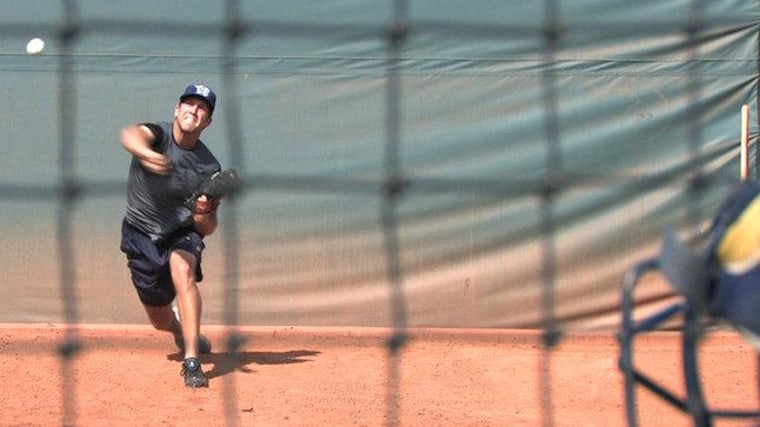When those curveballs from playoff pitchers like Phillies ace Roy Halladay near the plate, their sudden drop may be a mirage, scientists say.
It doesn't really matter, though, because most people still can't hit them.
That movement is called a "break," when the ball suddenly seems to drop sharply, usually resulting in the batter swinging above or below it.
The ball actually follows a smooth arc from pitcher to catcher, but seems to break when it moves from one part of the batter's vision to another, according to researchers Arthur Shapiro of American University and Zhong-Lin Lu of the University of Southern California.
The solution, they agree, has been the mantra of dads and coaches for decades: "Keep your eye on the ball."
And, as batters from Little League to the majors can attest, "Easier said than done."
"The argument been going on forever about whether (curveballs) break or not," observed Rob Gray, a psychology professor at Arizona State University who was not part of Shapiro and Lu's research team.
Scientists will tell you the ball follows a smooth curve, he said, while baseball players use terms like "falls off the table."
"We tell players to keep their eye on the ball, but you just can't," Gray said. "It is physically impossible to follow a major league baseball all the way to the plate."
"The curveball does curve, but the curve has been measured and shown to be gradual," Shapiro said. "It's always going to follow a parabolic path. But from a hitter's point of view, an approaching ball can appear to break, drop or do a whole range of unusual behaviors."
The problem is that how you see the ball differs depending on whether the eye is focused on it or if the peripheral vision at the side of the eye is being used, Lu and Shapiro report in a research paper published online Wednesday in the journal PLoS ONE.
Batters focus on the ball as it leaves the pitcher, Lu explained, but when it's about 20 feet from home plate they often switch to peripheral vision, then go back to central vision as the ball arrives at the plate.
That can cause the ball to appear to break as much as a foot, the researchers said.
It also explains the apparent rise of some fastballs, they added.
Indeed, in their research they won a prize for an illusion illustrating their theory demonstrating how an object falling in a straight line can seem to change direction.
Lu said he and Shapiro began studying the subject because they realize the "break" of a curve is inconsistent with physics.
Since then, he said, sports researchers have approached them for help in finding ways to defeat a curveball.
He said fans watching games on television also say a curveball appears to break when observed from behind home plate.
That is a geometric illusion, he said, caused by the fact that for the first part of a pitch, the viewer sees little or no vertical drop. Because the pitcher throws the ball at a slight upward angle, the first part of the pitch appears more or less flat. Then the drop seen near home plate surprises the eye.
Asked who throws the best curve, Lu had no hesitation in naming Dodgers' Hall of Famer Sandy Koufax.
Their findings aren't limited to baseball, Lu added.
"When we look at a scene, most of the images fall on the visual periphery, which has much lower resolution, although we don't normally notice the difference between central and peripheral vision," he said.
"We often confuse different signals in peripheral vision. For example, if we see a moving car with our peripheral vision, we may confuse the movement of the car with any movement in its immediate background.
